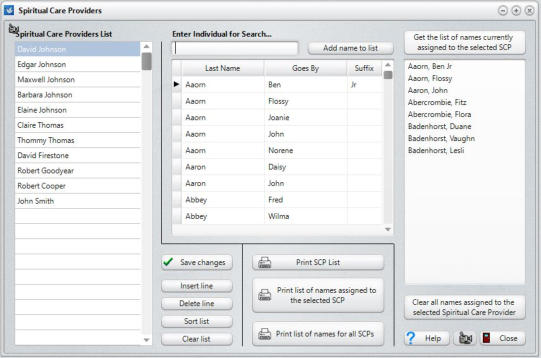

Leadership Involvement Using CMD
One important task for which the pastoral staff is responsible, is appropriate involvement in ministry by local church leaders. While some information must remain confidential to the pastoral staff, much of the informaiton that CMD tracks can be appropriately viewed and used by your church lay leadership. There are several fields and features within CMD that can help keep your leaders connected to your church members, while at the same time giving them a sense of partnership with the pastoral staff. Among the possibilities:Spiritual Care Providers/Visitation Tracking
One of CMD’s recent additions is the Spiritual Care Provider field and associated functions, is designed to allow you as a church staff to assign names in your congregation to leaders (elders, visitation team members, etc) for congregational care. That’s done on this dialog:

The dialog above left is where you can assign names to any spiritual care provider that you designate. Often elders or deacons are used as the
spiritual care providers, but they can be any group that you designate. The screen grab above right is a portion of the Enter/Modify/Delete
Names dialog showing where you can assign an SCP to the name currently showing on the screen.
Visitation Tracking Access
The spiritual care providers can be given access to the visitation tracking features within CMD. If you add your spiritual care provides to the Visitation Only user group in CMD, they can then log in to CMD themselves. When they do, they can only go one place - the Visitation tracking dialog. And the only names that appear when they log in are the names that they are assigned as spiritual care providers. So your leadership can log in and use CMD to record their visits. The information they place there is visible only to them and to pastoral staff members. You can also print visitation lists for your SCPs showing them the names for whom they are responsible with a date showing the date of a person’s last visit so that the SCP will know who he or she should visit next. Logging in to CMD can be done in the church office, of if you have the hosted CMD version your SCPs/elders can log in from home.Parish Group
Similar to SCP, except this is by family unit. You can assign a person to be responsible for a Parish group, and it’s easy to generate lists of names, addresses, and phone numbers so that your leadership will know who they are responsible for.Attendance Tracking
There is also an Attendance Only user group in CMD, so you can give a login permission to a team of attendance trackers if you wish. If you have the hosted CMD version, you can give them access to the phone and tablet attendance apps. They could use them to mark attendance in real time as they are sitting in the event (church, SS, VBS, mid-week services, board meetings, etc).Access to CMD
By making good use of the various user groups available in CMD, you can limit access to some of the more confidential information while giving general access to the program and its data. That opens up CMD as a ministry tool for your local church ministry leaders. If they are given access to your primary ministry tool, they will be able to use it as well to generate their own reports and lists as needed. Of course, they will either need to come in to the church office to use the software, or they can access it from home if you are using the hosted CMD version. Either way, if they have access to CMD and are trained in how to use it, they can gather the information they need first-hand that pertains to their ministry area. If they can do this, it will increase the sense of ministry partnership between the pastoral staff and lay ministry leaders.

- hostedsubscriptions
- software
- singlecomputer
- downloads
- sdasupport
- training
- unsuccessfulpurchase
- updatepurchasepage
- cmddetails
- testimonials
- newfeaturesguide
- stayingconnected
- involvedleaders
- cmdscreenshots
- purchase
- fullyhostedoption
- cancellationpolicy
- thinclients
- cmdtabletinfo
- tabletattendance
- phoneattendance
- visitationapps
- phoneappinfo
- phonetabletinfo
- News
- FAQ
- Contact
- maucpastors

















